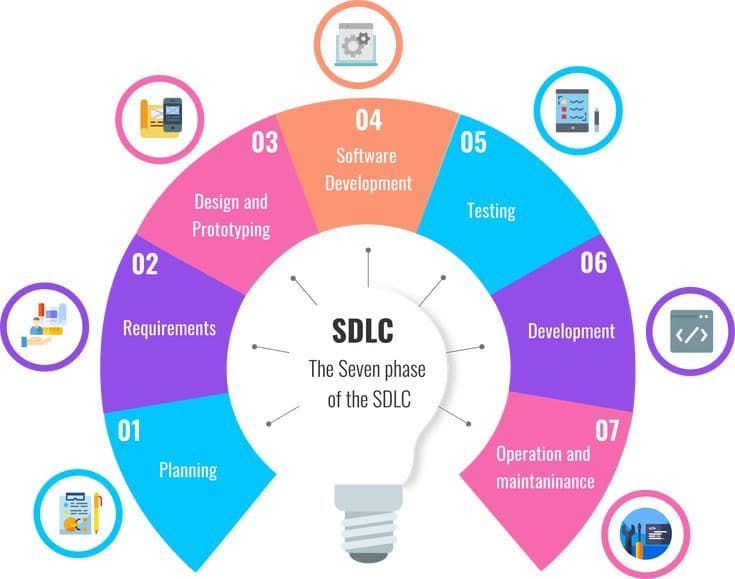Creating reliable software is not just about writing code, it requires a planned approach that balances strategy, execution, and flexibility. The journey from an idea to a usable product is often fraught with challenges, ranging from complex technical requirements, limited development time, to high user demands.
To address these challenges, many development teams adopt the Software Development Life Cycle (SDLC), a framework designed to ensure efficient, consistent processes that deliver the highest quality results.
In this discussion, we will explore why SDLC is so important, the stages involved, and the most commonly used models in the world of software development.
What is the SDLC?
The Software Development Life Cycle (SDLC) is a structured framework used in software development. This framework helps teams plan, build, and release software in a measurable and efficient manner.
The core of SDLC is to provide clear guidelines so that each development process can be controlled, ensuring that the final result meets user needs and established quality standards. For teams starting their first development project, understanding the SDLC is even more effective when paired with a clear guide on how to start software development step-by-step.
Why is SDLC Important?
SDLC is a solution to overcome various challenges in software development. These challenges include the ever-changing technological landscape, dynamic user or client needs, and technical resource limitations. These factors often become obstacles in producing high-quality software on time.
By using the SDLC approach, organizations can reap a number of important benefits, including:
1. Providing Clarity on the Process
SDLC divides software development into structured stages. This makes it easier for teams to understand the workflow, set priorities, and map risks in each phase. With a clear roadmap, the possibility of miscommunication or overlapping work can be minimized.
2. Improving Quality Control
This approach ensures that every part of the software undergoes a rigorous evaluation and testing process before moving on to the next phase. This way, issues can be detected early and fixed before they develop into major bugs that require more time and money to fix.
3. Ensuring Project Continuity
SDLC provides comprehensive documentation at each stage, so the project can continue even if there are changes in team members or organizational structure. This documentation also helps maintain consistency in development standards and facilitates cross-team collaboration.
4. Reducing Costs and Time
Thorough planning and clear schedules enable more efficient resource management. SDLC helps prevent rework, which is often the primary cause of budget overruns and project delays.
More than just a methodology, SDLC serves as a strategic roadmap that helps development teams navigate project complexities, maintain focus on key objectives, and ensure that the end result is of high quality and delivers tangible business value. By understanding these benefits, it is now clear that SDLC is not only a technical framework, but also an effective management strategy.
The question is, how does this process actually work from start to finish? To answer this, let's look at the stages of SDLC that are commonly used in software development, where each stage plays an important role in ensuring that the project runs smoothly and the end result meets user needs.

Phases of the Software Development Life Cycle
The Software Development Life Cycle (SDLC) model is usually divided into seven main phases, each with clear objectives and deliverables. Understanding the function of each phase is essential for teams to work in harmony and avoid costly mistakes.
1. Planning
This stage focuses on identifying project objectives, scope, required resources, and potential risks. The team develops a work plan, schedule, and cost estimates. With careful planning, the project has a clear direction and minimizes obstacles in the next stage.
2. Requirements
In this phase, user and system requirements are collected in detail. The team conducts interviews, surveys, or workshops with stakeholders to document features, technical criteria, and system limitations. The result is a Software Requirement Specification (SRS) that serves as a reference for development.
3. Design and Prototyping
Based on the defined requirements, the team designs the system architecture, database structure, workflow, and user interface. Prototyping is often used to provide an initial overview to the client so that feedback can be obtained before development begins. This phase strongly depends on creating an intuitive user experience, which is why mastering practical UX design principles is crucial.
4. Software Development
This stage involves the process of writing code (coding) according to the approved design. Developers work following coding standards and selected methods (e.g., Agile, Waterfall, or DevOps). Collaboration and version control are crucial in this phase to ensure the code remains organized.
5. Testing
Testing is conducted to ensure that the software is free of bugs, complies with specifications, and is ready for use. Types of testing may include unit testing, integration testing, system testing, and user acceptance testing (UAT). This stage helps maintain product quality and reliability.
6. Development (Deployment)
After passing testing, the software is deployed to the production environment. Deployment can be done all at once (big bang) or in phases (phased rollout). This process also includes server configuration, installation, and user training if needed.
7. Operation and Maintenance
The final stage ensures the system continues to run optimally. Activities include monitoring, post-release bug fixes, feature updates, and adjustments according to new requirements. Effective maintenance extends the software's lifespan and maintains user satisfaction.
The Most Commonly Used SDLC Models
In addition to having clear stages, SDLC can be implemented using various development models. Choosing the right model is very important because it will affect team effectiveness, final product quality, and user satisfaction. Here is an explanation of the five most commonly used SDLC models:
1. Waterfall Model
The Waterfall model follows a linear flow in which each stage must be completed before moving on to the next stage. The flow is like a waterfall flowing down without returning to the top.
Key characteristics: All stages are performed sequentially, Comprehensive documentation is created at the beginning.
Advantages: Simple structure and easy to understand, Suitable for projects with clear and unchanging requirements, Facilitates project management as each phase has clear deliverables.
Disadvantages: Not flexible to changing requirements, New bugs are often discovered in the final stages, resulting in high repair costs.
Example of use: Internal systems with stable requirements, such as a company's accounting system.
2. Agile Model
Agile uses an iterative and collaborative approach by dividing development into short sprints (1–4 weeks). Each sprint produces a version of the software that is ready to be tested and used.
Key features: Focus on team interaction and collaboration, Changes in requirements can be accommodated during development.
Advantages: Flexible to changes, Delivers results incrementally, allowing users to provide feedback more quickly, Accelerates time-to-market.
Disadvantages: Requires high discipline and communication, Difficult to predict in terms of time and cost if not properly managed.
Example of use: Mobile applications that follow market trends and require regular updates.
3. Iterative Model
This model builds software gradually through a series of iterations. Each initial version (prototype) is tested and improved before moving on to the next iteration.
Key characteristics: Development is done gradually, Feedback is used to improve the next version.
Advantages: Suitable for large projects with tight deadlines, Initial results can be used to validate ideas before full development.
Disadvantages: If not managed properly, the number of iterations can be excessive and waste resources, Requires careful planning to avoid confusion.
Example of use: E-commerce platforms that continuously add new features.
4. Spiral Model
The Spiral Model combines elements from Waterfall and Iterative, with an additional focus on identifying and managing risks in each development cycle.
Key features: There are planning, risk analysis, development, and evaluation phases in each round (spiral), Risks are prioritized before development continues.
Advantages: Highly suitable for high-risk projects, Allows for adjustments and improvements at every stage.
Disadvantages: Requires greater costs and time, The team must have strong risk analysis capabilities.
Example of use: Military or aerospace systems that require high security and reliability.
5. V-Model (Verification and Validation)
The V-Model is a variant of Waterfall where each development phase has a parallel testing phase. It is shaped like the letter “V” — the left side for development, the right side for testing.
Key features: Testing is planned from the outset, Testing is conducted alongside each development phase.
Advantages: High quality due to intensive testing from the start, Suitable for projects requiring strict quality standards.
Disadvantages: Not flexible to sudden changes, Requires comprehensive and detailed documentation.
Example of use: Healthcare systems or medical software that must comply with strict regulations.
"Great software is not just built, it’s crafted with passion and purpose."
Conclusion
The System Development Life Cycle (SDLC) is a critical foundation in software development, helping to ensure that each stage is structured, efficient, and aligned with objectives. By selecting the appropriate SDLC model, whether Waterfall, Agile, Iterative, Spiral, or V-Model organizations can optimize time, costs, and the quality of the final product.
For developers, understanding SDLC is not just about following processes but also about adapting to user needs, technological trends, and business challenges. In the fast-paced digital era, this understanding can be the difference between successful projects and those that fall behind.
If you plan to develop software, start by understanding the requirements, choose the appropriate SDLC model, and ensure your team is committed to quality and effective collaboration.
Want to start your software development project with the right strategy?
Contact us for a consultation and find the best SDLC model for your business needs.
💬 Get a free consultation → info@meda.technology



